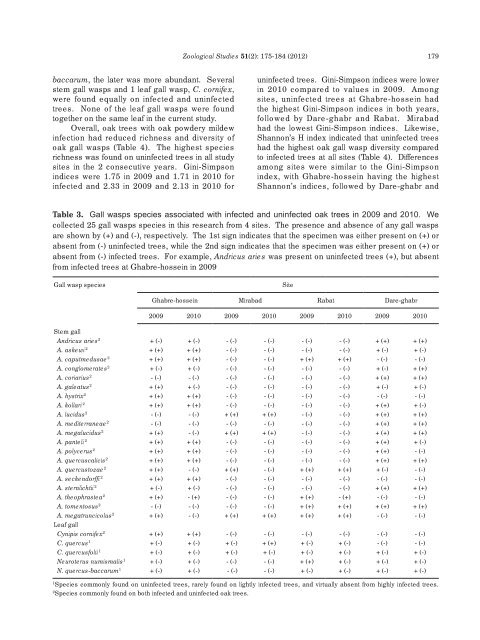Download PDF - Zoological Studies - Academia Sinica
Download PDF - Zoological Studies - Academia Sinica
Download PDF - Zoological Studies - Academia Sinica
You also want an ePaper? Increase the reach of your titles
YUMPU automatically turns print PDFs into web optimized ePapers that Google loves.
<strong>Zoological</strong> <strong>Studies</strong> 51(2): 175-184 (2012)<br />
179<br />
baccarum, the later was more abundant. Several<br />
stem gall wasps and 1 leaf gall wasp, C. cornifex,<br />
were found equally on infected and uninfected<br />
trees. None of the leaf gall wasps were found<br />
together on the same leaf in the current study.<br />
Overall, oak trees with oak powdery mildew<br />
infection had reduced richness and diversity of<br />
oak gall wasps (Table 4). The highest species<br />
richness was found on uninfected trees in all study<br />
sites in the 2 consecutive years. Gini-Simpson<br />
indices were 1.75 in 2009 and 1.71 in 2010 for<br />
infected and 2.33 in 2009 and 2.13 in 2010 for<br />
uninfected trees. Gini-Simpson indices were lower<br />
in 2010 compared to values in 2009. Among<br />
sites, uninfected trees at Ghabre-hossein had<br />
the highest Gini-Simpson indices in both years,<br />
followed by Dare-ghabr and Rabat. Mirabad<br />
had the lowest Gini-Simpson indices. Likewise,<br />
Shannon’s H index indicated that uninfected trees<br />
had the highest oak gall wasp diversity compared<br />
to infected trees at all sites (Table 4). Differences<br />
among sites were similar to the Gini-Simpson<br />
index, with Ghabre-hossein having the highest<br />
Shannon’s indices, followed by Dare-ghabr and<br />
Table 3. Gall wasps species associated with infected and uninfected oak trees in 2009 and 2010. We<br />
collected 25 gall wasps species in this research from 4 sites. The presence and absence of any gall wasps<br />
are shown by (+) and (-), respectively. The 1st sign indicates that the specimen was either present on (+) or<br />
absent from (-) uninfected trees, while the 2nd sign indicates that the specimen was either present on (+) or<br />
absent from (-) infected trees. For example, Andricus aries was present on uninfected trees (+), but absent<br />
from infected trees at Ghabre-hossein in 2009<br />
Gall wasp species<br />
Site<br />
Ghabre-hossein Mirabad Rabat Dare-ghabr<br />
2009 2010 2009 2010 2009 2010 2009 2010<br />
Stem gall<br />
Andricus aries 2 + (-) + (-) - (-) - (-) - (-) - (-) + (+) + (+)<br />
A. askewi 2 + (+) + (+) - (-) - (-) - (-) - (-) + (-) + (-)<br />
A. caputmedusae 2 + (+) + (+) - (-) - (-) + (+) + (+) - (-) - (-)<br />
A. conglomerates 2 + (-) + (-) - (-) - (-) - (-) - (-) + (-) + (+)<br />
A. coriarius 2 - (-) - (-) - (-) - (-) - (-) - (-) + (+) + (+)<br />
A. galeatus 2 + (+) + (-) - (-) - (-) - (-) - (-) + (-) + (-)<br />
A. hystrix 2 + (+) + (+) - (-) - (-) - (-) - (-) - (-) - (-)<br />
A. kollari 2 + (+) + (+) - (-) - (-) - (-) - (-) + (+) + (-)<br />
A. lucidus 2 - (-) - (-) + (+) + (+) - (-) - (-) + (+) + (+)<br />
A. mediterraneae 2 - (-) - (-) - (-) - (-) - (-) - (-) + (+) + (+)<br />
A. megalucidus 2 + (+) - (-) + (+) + (+) - (-) - (-) + (+) + (+)<br />
A. panteli 2 + (+) + (+) - (-) - (-) - (-) - (-) + (+) + (-)<br />
A. polycerus 2 + (+) + (+) - (-) - (-) - (-) - (-) + (+) - (-)<br />
A. quercuscalicis 2 + (+) + (+) - (-) - (-) - (-) - (-) + (+) + (+)<br />
A. quercustozae 2 + (+) - (-) + (+) - (-) + (+) + (+) + (-) - (-)<br />
A. seckendorffi 2 + (+) + (+) - (-) - (-) - (-) - (-) - (-) - (-)<br />
A. sternlichtii 2 + (-) + (-) - (-) - (-) - (-) - (-) + (+) + (+)<br />
A. theophrastea 2 + (+) - (+) - (-) - (-) + (+) - (+) - (-) - (-)<br />
A. tomentosus 2 - (-) - (-) - (-) - (-) + (+) + (+) + (+) + (+)<br />
A. megatruncicolus 2 + (+) - (-) + (+) + (+) + (+) + (+) - (-) - (-)<br />
Leaf gall<br />
Cynipis cornifex 2 + (+) + (+) - (-) - (-) - (-) - (-) - (-) - (-)<br />
C. quercus 1 + (-) + (-) + (-) + (+) + (-) + (-) - (-) - (-)<br />
C. quercusfolii 1 + (-) + (-) + (-) + (-) + (-) + (-) + (-) + (-)<br />
Neuroterus numismalis 1 + (-) + (-) - (-) - (-) + (+) + (-) + (-) + (-)<br />
N. quercus-baccarum 1 + (-) + (-) - (-) - (-) + (-) + (-) + (-) + (-)<br />
1<br />
Species commonly found on uninfected trees, rarely found on lightly infected trees, and virtually absent from highly infected trees.<br />
2<br />
Species commonly found on both infected and uninfected oak trees.

















